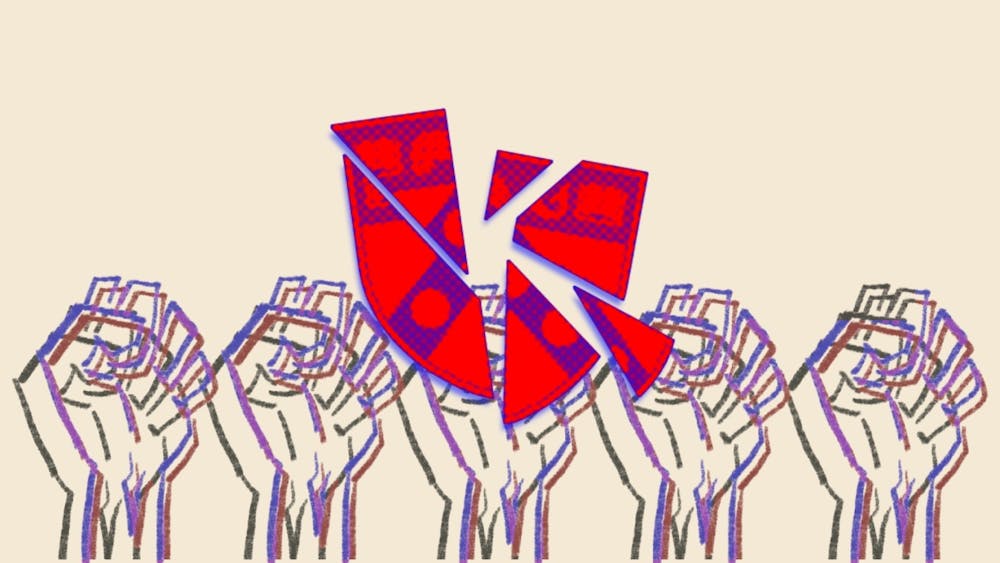It’s New Student Orientation, and thousands of bright–eyed freshmen flock onto Locust Walk. The streets are decorated with banners and balloons. The air seems to be filled with possibility. From the outset, Penn is a paradise for new students—a pristine institution that prides itself on its moral code and inclusivity.
But there’s much more going on beneath its glossy surface, and student activists have found a way to teach the fresh faces on campus that not everything is as it seems.
The Disorientation Guide is a longstanding student–run project, enduring from when its pamphlets were discreetly distributed in bulk during NSO to its virtual shift in 2020. It unpacks the countless times Penn has failed to act on its responsibility to the West Philadelphia community in detail, as well as the countless times Penn has directly perpetuated injustice. The essays that make up the guide are put together by different groups on campus—including Megha Neelapu (C ‘24), a student activist who has been involved with the Disorientation Guide since her first year and with advocacy for much longer.
Megha began their journey by following America’s macro–political landscape in 2016. “I started [by] following Bernie Sanders … I think a lot of people our age got into advocacy that way,” she says. Despite working on campaigns for the rest of high school and doing a “little internship on the Hill,” they shifted their focus from electoral politics to the more “radicalized” bottom–up approach to activism. By her own admittance, community organization is something she’s a big believer in, which eventually led them to activism at Penn.

Photo Courtesy of Megha Neelapu.
It’s easy to sense the warmth with which Megha refers to her fellow activists and students, especially when it concerns the Save the UC Townhomes coalition. After attending a block–party protest and another protest on 34th and Walnut, they noticed how many Penn students and community members showed up to advocate for the Townhomes tenants, visibly excited to see an outpouring of local support. “I really hope UC Townhomes works out and Penn uses their influence to help the residents … in their fight,” she says. As of now, though, it serves as testament to Penn allowing for no significant change to be made. And Megha hopes to use the Disorientation Guide to educate more people on these issues.
A discussion of the university's failings this past year, from the aforementioned UC Townhomes conflict to the Mackenzie Fierceton debacle, steers the conversation towards Megha’s engagement with the Disorientation Guide. The guide is the passion project of Penn’s activist circles, a critique of Penn’s administrative practices, and a love letter for advocacy. She describes her first run–in with the Disorientation Guide before her virtual freshman year: “I remember reading it and [thinking] it was really revealing about the kind of institution Penn is, and I knew that I wanted to be involved in it after I read it,” they say with sincerity. “The summer after my freshman year … another coordinator and I worked on the Fossil Free Penn article for [the guide],” Megha says. The rest is history.
This May, Megha took matters into their own hands after noticing that a lot of the people previously heading the Disorientation Guide were graduating. She describes organizing a new group for the upcoming Disorientation Guide in extremely casual terms, emphasizing how collaborative of an effort it is and how decisions regarding the guide are made by all members. “It’s not like I’m the girlboss in charge,” they laugh. “It’s a group effort for sure.”
Interconnectedness is something Megha seems to value—not only during the process of working on the guide, but also in the finished product. Although physical pamphlets are no longer given out, she notes the importance of preserving its pamphlet–like format, with essays flowing through each other and actively tying everything together in the conclusion. “A lot of these issues are interconnected, so that’s something we try to emphasize,” they say.
Megha feels that all students at Penn should be aware of the topics discussed in the Disorientation Guide—especially incoming students unfamiliar with the University's flaws. To Megha, the guide dismantles Penn’s “image–focused” nature and exposes “all the shit [Penn] gets up to” that students deserve to know before they start a new part of their lives here. As an institution in a position of power, Penn has the ability to craft and push its own narrative of local support. The guide makes sure that students and active members of the community can verbalize their side of the story and address the parts of Penn’s legacy that aren't so benevolent.
But it’s also a great way to “get students excited about advocacy work.” They mention how a guide like this is invaluable because it gives new students an idea of what groups they’d like to join upon arriving on campus and which issues speak to them on a personal level. “Especially since protests and advocacy [since 2020] has become a Gen Z thing; I think a lot of students are interested in that,” she says.
For Megha, the guide is not only a way to dismantle the curated show Penn wants to put on, but it’s a work infused with dedication and passion—including their own.
Stay tuned for the 2022 Disorientation Guide release this fall.

